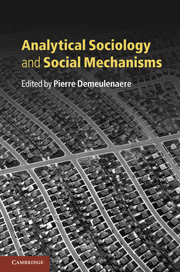Book contents
- Frontmatter
- Contents
- List of figures
- List of tables
- List of contributors
- Introduction
- Part I Action and mechanisms
- Part II Mechanisms and causality
- 5 Generative process model building
- 6 Singular mechanisms and Bayesian narratives
- 7 The logic of mechanistic explanations in the social sciences
- 8 Social mechanisms and explanatory relevance
- 9 Causal regularities, action and explanation
- Part III Approaches to mechanisms
- Index
- References
5 - Generative process model building
Published online by Cambridge University Press: 05 June 2012
- Frontmatter
- Contents
- List of figures
- List of tables
- List of contributors
- Introduction
- Part I Action and mechanisms
- Part II Mechanisms and causality
- 5 Generative process model building
- 6 Singular mechanisms and Bayesian narratives
- 7 The logic of mechanistic explanations in the social sciences
- 8 Social mechanisms and explanatory relevance
- 9 Causal regularities, action and explanation
- Part III Approaches to mechanisms
- Index
- References
Summary
Introduction
Theoretical sociology deals with theoretical problems and methods, formulating principles and models that incorporate generative mechanisms in applications to abstract or concrete cases within a specified scope (Fararo 1989). This approach is “generalizing” rather than “historical” or particularizing in its orientation (Berger et al. 1972). Part of what this means is that the importance of an empirical study is tied to the theoretical problem in the context of explanatory theory development. This viewpoint has governed the growth of a variety of theoretical research programs in sociology (Berger and Zelditch 2002). Theory-driven studies of cooperation, such as those stimulated by the pioneering work of Axelrod (1984), are in this spirit.
Given the generalizing orientation, we can distinguish between present-day embodiments of it and certain mid-twentieth-century efforts that are often grouped under the rubric “general theory.” I am referring to not only Parsons but also, by contrast, Homans. Their earlier efforts differ from present-day contributions in that they had the aim of general theoretical synthesis. They aspired to create a solid theoretical foundation for not only sociology but the other social sciences as well. Parsons initiated his synthesis efforts with a focus on the problem of social order. Less obviously, this was true of Homans as well. The order problem in his theoretical works is transmuted into a theory of spontaneous order – how structures of stable social relations emerge in social interaction, as in the treatment of what he called “the internal system” (Homans 1950).
- Type
- Chapter
- Information
- Analytical Sociology and Social Mechanisms , pp. 99 - 120Publisher: Cambridge University PressPrint publication year: 2011
References
- 1
- Cited by



